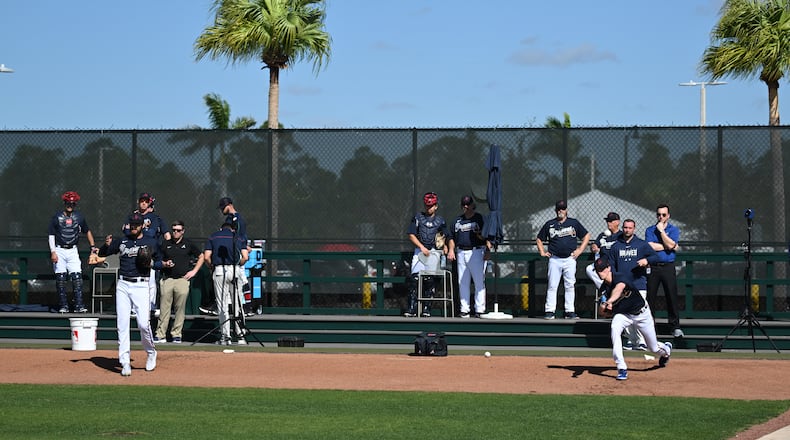NORTH PORT, Fla. — After Ronald Acuña blasted a home run off Max Fried in live batting practice Wednesday at CoolToday Park, Fried remarked that he looked up to the pitch clock and saw it winding down and simply needed to throw a pitch in time.
To be clear, this might not have been Fried’s fault, as manager Brian Snitker said the clock may not have been running properly – which would make sense that Fried thought he had more time. But this live batting practice session underscored the different nuances of the pitch timer and the adjustment required by all parties involved. (Fried, Spencer Strider and Kirby Yates threw well Wednesday, and we’ll get to that eventually).
That moment with Fried?
That’s why the Braves are using the pitch clock now, before spring games even begin.
“So they feel it and experience it,” Snitker said. “I’m sure Max will relay what he experienced, and all the guys that were doing it on the back fields, too.”
If no one is on base, a pitcher has 15 seconds – from the time he catches the ball – to begin his motion. He has 20 seconds with runners on base.
Fried, who was otherwise terrific Wednesday, seemed to be caught off-guard by the clock running down to its final seconds. Perhaps he thought he had 20 seconds. Live batting practice isn’t like an organized game – it’s simulated, and that allows for some discrepancies.
But after giving up the home run to Acuña, Fried told his coaches and teammates who were watching that he looked up at the clock and saw it in its final seconds. His reaction seemed to imply that he just had to begin his motion to throw a pitch to beat the timer.
“I think that’s a thing, especially out of the windup: You can’t stop the clock,” Snitker said after the workout. “That’s when I think, in a situation like that, the catcher is just going to have to use a mound visit.”
Pitchers have two disengagements – stepping off the rubber or attempting a pickoff – per plate appearance, and these will reset the timer. This limit is reset if a runner advances during the plate appearance. If a pitcher makes a third disengagement with no one on base, for example, a ball will be assessed by the umpire. If that disengagement comes with runners on base, it will be a balk if the pitcher doesn’t successfully pick off the runner.
Mound visits don’t count as disengagements, which is why Snitker, in the quote above, said catchers will need to burn them if a pitcher needs a quick reset. However, teams will have only five mound visits each game but will get a sixth if they use all five before the ninth inning.
“I think there’ll be some getting used to it,” Snitker said. “I think the biggest thing is if the thing starts getting hairy, they don’t have that opportunity to calm things down a little bit and catch their breath. You got to keep going. I think some of the catchers, if they see that coming down, they’re just going to have to use a mound visit.”
In the main stadium, Fried and Strider both threw two simulated innings. Yates threw one simulated inning. Unofficially, Strider threw 29 pitches. Fried threw 33. Yates hurled 18.
The hitters: Acuña, Ozzie Albies, Eli White, Joe Dunand (non-roster invitee) and Forrest Wall (non-roster invitee).
Here’s how it went:
First simulated inning: Fried (throwing to catcher Sean Murphy)
Fried gets White to pop out to him in three pitches.
Fried strikes out Acuña on four pitches.
Fried strikes out Wall on four pitches.
Fried strikes out Dunand on three pitches.
“That first inning with Max was about as good as it gets,” Snitker said.
Second inning: Strider (throwing to catcher Travis d’Arnaud)
Strider strikes out Albies on six pitches after falling behind 3-1. (After one pitch, Albies remarked that Strider’s ball had good carry, and Snitker later said, “The balls they think a lot of the time are down are strikes. It does have good carry.”)
Strider strikes out Acuña on four pitches, working the slider into the at-bat.
Strider gets White to fly out to right field on five pitches.
“I think that ball gets on top of you, and it’s a little different,” Snitker said of Strider. “It’s hard to hit.”
Third inning: Fried (throwing to d’Arnaud)
Fried strikes out Wall on three pitches.
Fried gets Dunand to ground out on four pitches.
Fried gives up the home run to Acuña on the third pitch.
Fried gets White to ground out on the third pitch, and Fried makes a nifty snag on the comebacker.
Fried gets Wall to ground out on six pitches.
Fourth inning: Strider (throwing to Murphy)
Strider strikes out Dunand on four pitches.
Strider gets Albies to ground out to first base on three pitches.
Strider strikes out Acuña on four pitches.
Strider strikes out White on three pitches.
Fifth inning: Yates (throwing to d’Arnaud)
Yates strikes out Albies on four pitches.
Yates throws four pitches to Wall, but it’s unclear if it was a strikeout or a walk. (“Nice pitch, Kirb!” Fried yells after one of the pitches.)
Yates walks Dunand on seven pitches. (“One more,” Yates tells pitching coach Rick Kranitz after this, pleading for one last batter.)
Yates gets Acuña to ground out on three pitches.
Snitker came away impressed from the live batting practice session.
“It was really good,” he said. “And we had a bunch of them that wanted to hit. I know some of them were ticked off because they couldn’t get whacks, but we only had so many (spots).”
About the Author
Keep Reading
The Latest
Featured



